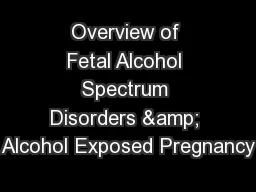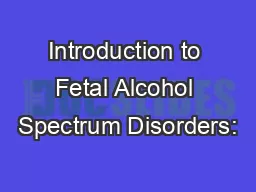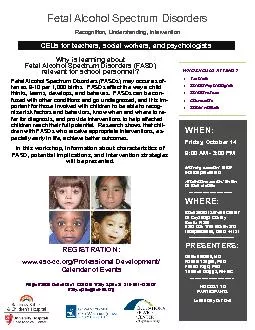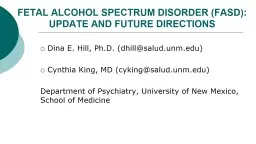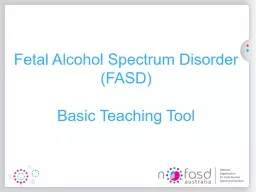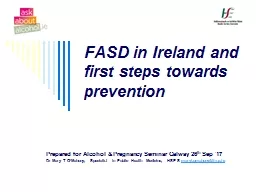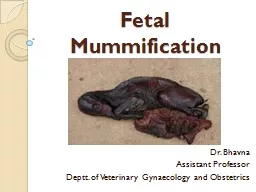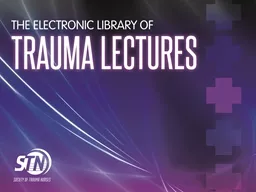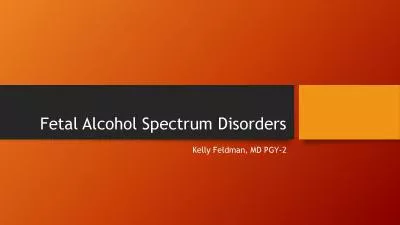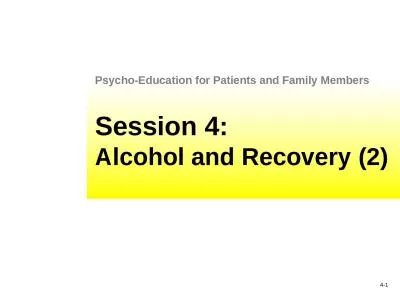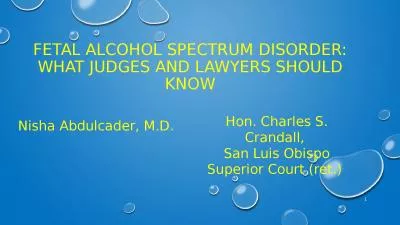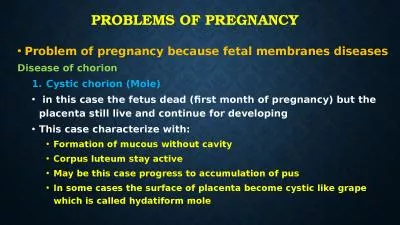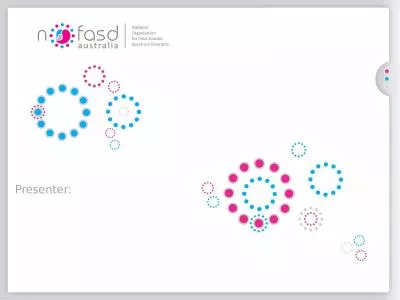PPT-Overview of Fetal Alcohol Spectrum Disorders & Alcohol Exposed Pregnancy
Author : altigan | Published Date : 2020-06-15
Practice amp Implementation Center South at Baylor College of Medicine Learning Objectives Describe the effects of alcohol exposure during pregnancy Identify the
Presentation Embed Code
Download Presentation
Download Presentation The PPT/PDF document "Overview of Fetal Alcohol Spectrum Disor..." is the property of its rightful owner. Permission is granted to download and print the materials on this website for personal, non-commercial use only, and to display it on your personal computer provided you do not modify the materials and that you retain all copyright notices contained in the materials. By downloading content from our website, you accept the terms of this agreement.
Overview of Fetal Alcohol Spectrum Disorders & Alcohol Exposed Pregnancy: Transcript
Practice amp Implementation Center South at Baylor College of Medicine Learning Objectives Describe the effects of alcohol exposure during pregnancy Identify the signs and symptoms of fetal alcohol spectrum disorders . Summer 2013. Risk Factors. Age – under 17 over 35. Gravida. and Parity. Socioeconomic status. Psychological well-being. Predisposing chronic illness – diabetes, heart conditions, renal. Pregnancy related conditions – hyperemesis . The Medical Assistant’s Role . Funding for this presentation was made possible by the Centers for Disease Control and Prevention. The views expressed in written materials and by speakers do not necessarily reflect the official policies of the Department of Health and Human Services, nor does the mention of trade names, commercial practices, or organizations imply endorsement by the U.S. Government.. Recognition, Understanding, Intervention WHO SHOULD ATTEND? Teachers School Psychologists School nurses Counselors Social workers WHEN: Friday, October 14 9:00 AM - 3:00 PM Morni Dina E. Hill, Ph.D. (dhill@salud.unm.edu). Cynthia King, MD (cyking@salud.unm.edu). Department of Psychiatry, University of New Mexico, School of Medicine. DISCLOSURES. Dr. Hill has a contract with IHS for neuropsychological assessment of children through her private practice.. (FASD) . Basic Teaching Tool. This PowerPoint is provided by NOFASD Australia to enable others with an interest in the topic to deliver information sessions and increase community knowledge and awareness of FASD. . Prepared for . Alcohol & Pregnancy Seminar Galway 26. th. Sep ‘17. Dr Mary T O’Mahony, Specialist in Public Health . Medicine, HSE-S . maryt.omahony@hse.ie. . National Geographic Feb 1992. http://www.faslink.org/national%20geographic%20-%20article%20on%20fetal%20alcohol.htm. Bhavna. Assistant Professor. Deptt. . of Veterinary Gynaecology and Obstetrics. Introduction. Failure of pregnancy is usually divided into stages based on the fetus’s development and potential viability: embryonic mortality and fetal mortality. . At the conclusion of this presentation the participant will be able to:. Discuss the . epidemiology, incidence and prevention . of trauma . in pregnancy . Identify . physiologic & anatomic . changes in pregnancy . Kelly Feldman, MD PGY - 2 Epidemiology • Most common form of preventable developmental delay and intellectual disability • Approximately 1/5 women of childbearing age report binge drinking • 5 Psycho-Education for Patients and Family Members. Alcohol and Women. Compared with men, women develop alcohol-related disease more quickly and with less alcohol.. 4-. 2. Alcohol and Pregnancy. Babies born to mothers who drank during pregnancy may have mental retardation or other learning and behavioral problems.. Nisha . Abdulcader. , M.D. . Hon. C. harles. S. Crandall, . San Luis Obispo Superior Court (ret.) . 1. Fetal Alcohol Syndrome. Partial Fetal Alcohol Syndrome. . Alcohol Related. Neurodevelopmental. because fetal membranes diseases. . D. isease of chorion . Cystic chorion (Mole). in this case the fetus dead (first month of pregnancy) but the placenta still live and continue for developing . This case characterize with:. What causes FASD?. Prevalence in Australia. FASD 4%. NHMRC guidelines recommend. Woman who are pregnant or breastfeeding. A. To prevent harm from alcohol to their unborn child, women who are pregnant or are planning a pregnancy should not drink alcohol.. Sameena Ghayur. Associate Professor . Shifa College of Medicine . sameena.ghayur@yahoo.com. . Placenta and the Fetal membranes. . Maternal and fetal circulation separate . Nourishes the fetus . Eliminates fetal wastes .
Download Document
Here is the link to download the presentation.
"Overview of Fetal Alcohol Spectrum Disorders & Alcohol Exposed Pregnancy"The content belongs to its owner. You may download and print it for personal use, without modification, and keep all copyright notices. By downloading, you agree to these terms.
Related Documents

